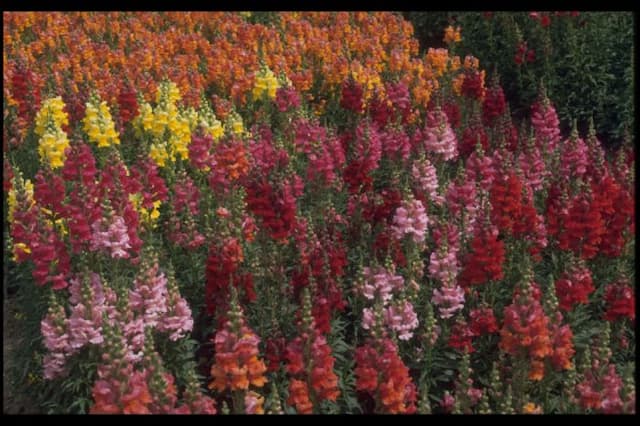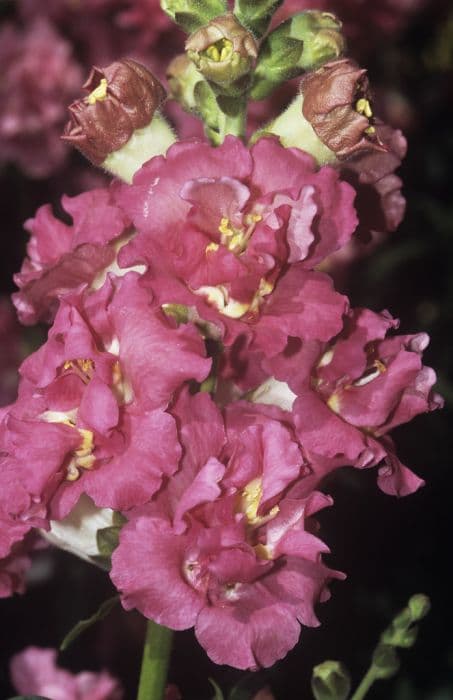Fairy Foxglove Erinus alpinus

ABOUT
The Fairy Foxglove is a charming, perennial plant known for its quaint beauty and alpine origins. This delightful flora showcases a rosette of small, rich green leaves that often have a slightly hairy texture. These leaves provide a lush backdrop to the plant's standout feature: its flowers. The blooms of the Fairy Foxglove are tubular in shape, looking like little trumpets, and they are known for being profusely clustered. The petals can be vivid in color, ranging from deep purples and pinks to softer shades of lavender and sometimes white, often with a delicate veining pattern that adds to their intricate appearance. The Fairy Foxglove typically flowers in the summertime, presenting a vibrant and eye-catching display that adds a pop of color to rock gardens, crevices, and the front edges of perennial borders. The flowers are not only a visual delight but also attract a variety of pollinators, including bees and butterflies, which are drawn to their inviting shape and shades. This plant is well-loved for its fairytale-like aura bringing a touch of Alpine magic to wherever it is grown.
About this plant
 Names
NamesSynonyms
Alpine Balsam, Fairy Foxglove
Common names
Erinus alpestris, Erinus pumilus, Erinus hirsutus, Antirrhinum erinus
 Toxicity
ToxicityTo humans
Erinus alpinus, commonly known as Fairy Foxglove, is generally not known to be toxic to humans. There is limited information on its toxicity, but it is not typically recognized for having poisonous properties. Therefore, if ingested, it is not expected to cause significant symptoms of poisoning. However, as with any plant, individual allergic reactions or sensitivities are possible. It is always recommended to exercise caution and avoid ingesting plants not identified as safe for human consumption.
To pets
Fairy Foxglove, or Erinus alpinus, is not commonly listed as a toxic plant to pets. There is little to no evidence to suggest that it poses a significant threat if ingested by animals such as dogs or cats. As symptoms of poisoning are not widely reported or documented, it is not known to be a cause for concern. Nevertheless, pet owners should always be vigilant and discourage pets from eating plants, especially those not specifically identified as safe for animals.
 Characteristics
CharacteristicsLife cycle
Perennials
Foliage type
Evergreen
Color of leaves
Green
Flower color
Pink
Height
0.5 feet (15 cm)
Spread
0.5 feet (15 cm)
Plant type
Herb
Hardiness zones
4
Native area
Europe
Benefits
 General Benefits
General Benefits- Attracts Pollinators: Erinus alpinus, commonly known as fairy foxglove, is known to attract bees and butterflies, which is beneficial for garden pollination.
- Aesthetic Appeal: With its striking purple, pink, or sometimes white flowers, fairy foxglove adds color and beauty to rock gardens and alpine displays.
- Low Maintenance: Fairy foxglove is easy to grow and does not require much care, making it an ideal choice for gardeners of all skill levels.
- Drought Tolerant: Once established, it can tolerate periods of drought, reducing the need for frequent watering.
- Cold Hardy: It can survive in cold temperatures, making it suitable for mountainous and alpine regions.
- Erosion Control: Its ability to grow in poor soils and its mat-forming habit helps stabilize soil and prevent erosion on slopes.
- Wildlife Habitat: Provides shelter and habitat for small wildlife and insects in the garden ecosystem.
 Medical Properties
Medical PropertiesThis plant is not used for medical purposes.
 Air-purifying Qualities
Air-purifying QualitiesThis plant is not specifically known for air purifying qualities.
 Other Uses
Other Uses- Erinus alpinus, commonly known as Alpine Balsam, can be used in rock gardens where its ability to grow in crevices adds aesthetic value to the rocky landscape.
- In miniature gardening, the small and compact growth of Alpine Balsam makes it a suitable choice for creating scaled-down landscapes or fairy gardens.
- The plant is useful in education for teaching botany, especially about alpine flora and survival strategies in harsh environments.
- Alpine Balsam can be used in butterfly gardens as it provides nectar for various species of butterflies and other pollinators taking refuge in garden spaces.
- As a photographer's subject, the vibrant colors of Alpine Balsam can be captivating, making it an intriguing component in macro photography.
- Its dense, mat-forming habit provides ground cover, reducing soil erosion on slopes or terraces in gardens and landscapes.
- Alpine Balsam can be grown in containers on balconies or patios, offering a touch of alpine charm to urban environments.
- The plant can be a natural ingredient in potpourri due to its colorful appearance, adding visual appeal when dried and mixed with other aromatic plants.
- In culinary arts, the edible flowers of the Alpine Balsam could potentially be used as a decorative garnish for dishes, though this is not a common practice.
- During festive seasons, Alpine Balsam can potentially be incorporated into wreaths or holiday decorations for its bright flowers and evergreen presence in some climates.
Interesting Facts
 Feng Shui
Feng ShuiThe Fairy Foxglove is not used in Feng Shui practice.
 Zodiac Sign Compitability
Zodiac Sign CompitabilityThe Fairy Foxglove is not used in astrology practice.
 Plant Symbolism
Plant Symbolism- Endurance and Survival: Erinus alpinus, also known as Fairy Foxglove, is native to the mountainous regions of Europe, symbolizing the ability to endure challenging conditions and survive in harsh environments.
- Rarity and Preciousness: Fairy Foxglove is a rare and less common plant, which can symbolize something precious and valued, much like a rare gem or treasure.
- Charm and Enchantment: The common name Fairy Foxglove evokes a sense of magic and whimsy, often symbolizing charm and enchantment associated with fairy tales and mythical stories.
 Water
WaterFairy Foxglove needs to be watered when the top inch of soil feels dry to the touch, which generally means once or twice a week during active growth periods. Use room temperature water and aim to moisten the soil evenly, avoiding waterlogging. A good rule of thumb is to provide approximately 8-16 ounces of water per plant, depending on the pot size and environmental conditions. During the winter dormancy, reduce watering frequency to prevent root rot.
 Light
LightFairy Foxglove thrives best in partial shade to full sun conditions. It should be placed in a spot where it can receive bright, indirect light for several hours each day, while being protected from the harsh midday sun, which can scorch its leaves.
 Temperature
TemperatureFairy Foxglove prefers cooler temperatures, thriving in a range between 50-70 degrees Fahrenheit. It can withstand minimum temperatures down to 40 degrees Fahrenheit but may suffer if exposed to temperatures above 80 degrees Fahrenheit. The ideal temperature conditions would therefore be on the cooler side, mimicking its alpine origins.
 Pruning
PruningPruning Fairy Foxglove is mainly done to remove dead or faded flowers to encourage further blooming. It should ideally be pruned after the flowering period to maintain a compact and attractive shape. Pruning can be performed yearly or as needed when the plant appears to be getting leggy.
 Soil
SoilFairy Foxglove requires well-draining, loamy soil with a slightly acidic to neutral pH between 6.0 and 7.0. A mix of peat, coarse sand, and rich garden soil in equal parts can create an optimal growing medium for this alpine plant.
 Repotting
RepottingFairy Foxglove should be repotted every 2-3 years to refresh the soil and accommodate growth. Spring is the most suitable time for repotting this compact perennial.
 Humidity & Misting
Humidity & MistingFairy Foxglove thrives in moderate humidity levels typical of its native mountainous habitats. It does not require high humidity, making it well-suited to indoor environments with average humidity.
 Suitable locations
Suitable locationsIndoor
Place Fairy Foxglove in bright, indirect light and keep the soil moist.
Outdoor
Plant Fairy Foxglove in rock gardens with partial sun and well-drained soil.
Hardiness zone
4-8 USDA
 Life cycle
Life cycleErinus alpinus, commonly known as Alpine Balsam, is a perennial plant. It begins its life cycle as a seed, which germinates when conditions are favorable, typically in spring. The seedling grows into a rosette of leaves close to the ground, and as it matures, it develops a sturdy root system. In late spring to early summer, Erinus alpinus produces flowering stalks with small, vividly colored flowers that are typically pink, purple, or white. After pollination, these flowers develop into fruit capsules containing seeds, completing the reproductive cycle. As a perennial, the Alpine Balsam will enter a period of dormancy during the winter months before resuming growth in the following spring.
 Propogation
PropogationPropogation time
Spring-Early Summer
Propogation: Erinus alpinus, commonly known as the alpine balsam, is best propagated through seed sowing. The ideal time to sow seeds is either in the autumn or right after the last frost in spring. When propagating via seeds, it's important to use well-draining soil and to cover the seeds lightly, as they require light to germinate. The seeds should be kept moist, and at a temperature of about 68 degrees Fahrenheit (20 degrees Celsius). Germination can take anywhere from 2 to 4 weeks, depending on conditions. Once seedlings develop true leaves and are big enough to handle, they can be transplanted into individual pots or directly into the garden if the outdoor conditions are suitable.





![Snapdragon [Pretty in Pink]](/_next/image?url=https%3A%2F%2Fplants-admin.emdemapps.com%2Fimages%2Fplants%2F%2Fimages%2F604b5cb3b5385.png&w=640&q=75)



